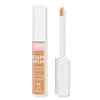What's inside
What's inside
 Key Ingredients
Key Ingredients

No key ingredients
 Benefits
Benefits

 Concerns
Concerns

 Ingredients Side-by-side
Ingredients Side-by-side

Dimethicone
EmollientIsotridecyl Isononanoate
EmollientTriethylhexanoin
MaskingWater
Skin ConditioningCeresin
Emulsion StabilisingPolyethylene
AbrasiveMethyl Methacrylate Crosspolymer
Diisostearyl Malate
EmollientVinyl Dimethicone/Methicone Silsesquioxane Crosspolymer
Isononyl Isononanoate
EmollientEuphorbia Cerifera Wax
Phytosteryl/Octyldodecyl Lauroyl Glutamate
Skin ConditioningCaprylic/Capric Triglyceride
MaskingOzokerite
Emulsion StabilisingGlycerin
HumectantIsododecane
EmollientSilica
AbrasivePEG-9 Polydimethylsiloxyethyl Dimethicone
EmulsifyingHelianthus Annuus Seed Wax
Skin ConditioningAcrylates/Dimethicone Copolymer
Skin ConditioningJojoba Esters
EmollientDimethicone/PEG-10/15 Crosspolymer
Phenoxyethanol
PreservativeCaprylyl Glycol
EmollientSodium Hyaluronate
HumectantPotassium Sorbate
PreservativeHexylene Glycol
EmulsifyingTocopherol
AntioxidantAscorbyl Palmitate
AntioxidantTitanium Dioxide
Cosmetic ColorantIron Oxides
Mica
Cosmetic ColorantDimethicone, Isotridecyl Isononanoate, Triethylhexanoin, Water, Ceresin, Polyethylene, Methyl Methacrylate Crosspolymer, Diisostearyl Malate, Vinyl Dimethicone/Methicone Silsesquioxane Crosspolymer, Isononyl Isononanoate, Euphorbia Cerifera Wax, Phytosteryl/Octyldodecyl Lauroyl Glutamate, Caprylic/Capric Triglyceride, Ozokerite, Glycerin, Isododecane, Silica, PEG-9 Polydimethylsiloxyethyl Dimethicone, Helianthus Annuus Seed Wax, Acrylates/Dimethicone Copolymer, Jojoba Esters, Dimethicone/PEG-10/15 Crosspolymer, Phenoxyethanol, Caprylyl Glycol, Sodium Hyaluronate, Potassium Sorbate, Hexylene Glycol, Tocopherol, Ascorbyl Palmitate, Titanium Dioxide, Iron Oxides, Mica
 Reviews
Reviews

Ingredients Explained
These ingredients are found in both products.
Ingredients higher up in an ingredient list are typically present in a larger amount.
Glycerin is already naturally found in your skin. It helps moisturize and protect your skin.
A study from 2016 found glycerin to be more effective as a humectant than AHAs and hyaluronic acid.
As a humectant, it helps the skin stay hydrated by pulling moisture to your skin. The low molecular weight of glycerin allows it to pull moisture into the deeper layers of your skin.
Hydrated skin improves your skin barrier; Your skin barrier helps protect against irritants and bacteria.
Glycerin has also been found to have antimicrobial and antiviral properties. Due to these properties, glycerin is often used in wound and burn treatments.
In cosmetics, glycerin is usually derived from plants such as soybean or palm. However, it can also be sourced from animals, such as tallow or animal fat.
This ingredient is organic, colorless, odorless, and non-toxic.
Glycerin is the name for this ingredient in American English. British English uses Glycerol/Glycerine.
Learn more about GlycerinMica is a naturally occurring mineral used to add shimmer and color in cosmetics. It can also help improve the texture of a product or give it an opaque, white/silver color.
Serecite is the name for very fine but ragged grains of mica.
This ingredient is often coated with metal oxides like titanium dioxide. Trace amounts of heavy metals may be found in mica, but these metals are not harmful in our personal products.
Mica has been used since prehistoric times throughout the world. Ancient Egyptian, Indian, Greek, Roman, Aztec, and Chinese civilizations have used mica.
Learn more about MicaWater. It's the most common cosmetic ingredient of all. You'll usually see it at the top of ingredient lists, meaning that it makes up the largest part of the product.
So why is it so popular? Water most often acts as a solvent - this means that it helps dissolve other ingredients into the formulation.
You'll also recognize water as that liquid we all need to stay alive. If you see this, drink a glass of water. Stay hydrated!
Learn more about Water